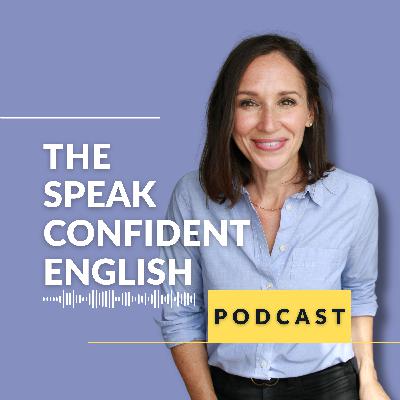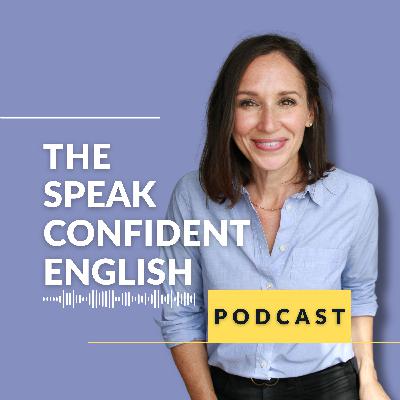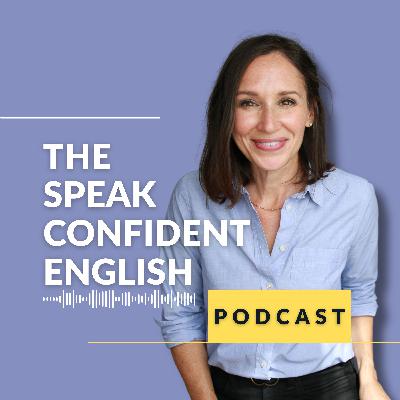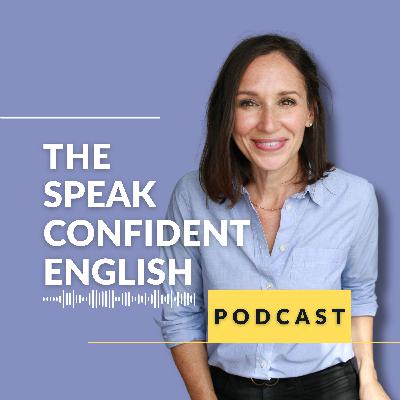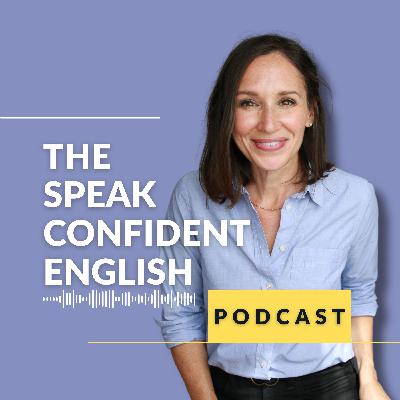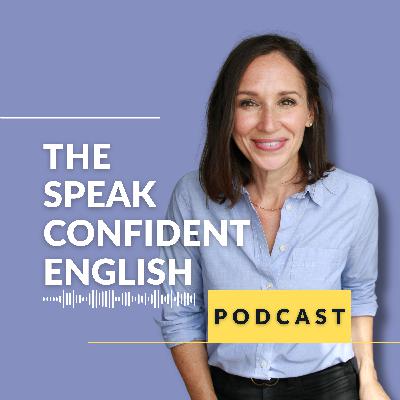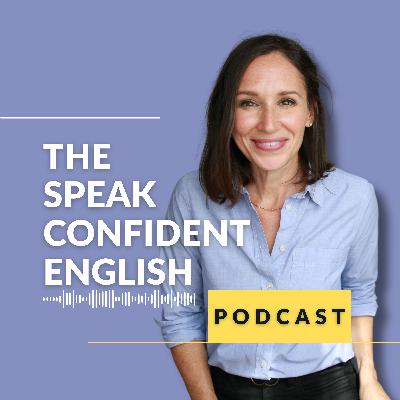Discover The Speak Confident English Podcast
The Speak Confident English Podcast

The Speak Confident English Podcast
Author: Annemarie — Speak Confident English
Subscribed: 111Played: 487Subscribe
Share
© Annemarie — Speak Confident English
Description
Build your English confidence and speak fluently — even if you feel shy, stuck, or nervous right now.
I'm Annemarie, the founder of Speak Confident English and an English fluency coach with 20+ years of experience. Every week, I share proven strategies to help you go from, “I understand English,” to “I speak it clearly and confidently.”
With every episode, learn exactly what to say — and how to say it — so you can speak with calm clarity at work, in conversations, and in everyday life.
🎧 Free Fluency Training →
speakconfidentenglish.com/say-what-you-want-in-english
I'm Annemarie, the founder of Speak Confident English and an English fluency coach with 20+ years of experience. Every week, I share proven strategies to help you go from, “I understand English,” to “I speak it clearly and confidently.”
With every episode, learn exactly what to say — and how to say it — so you can speak with calm clarity at work, in conversations, and in everyday life.
🎧 Free Fluency Training →
speakconfidentenglish.com/say-what-you-want-in-english
26 Episodes
Reverse
Have you ever wanted to give a compliment in English to a colleague or manager — but stopped yourself because you weren’t sure what to say? Maybe you worried it would sound awkward or too personal. In this episode, I’ll show you exactly how to give compliments in English at work with confidence. You’ll learn two simple formulas you can copy, plus real examples of workplace English compliments that sound natural and professional. Here’s what you’ll discover in this lesson: Why compliments matter in English-speaking workplaces 2 clear structures for professional English compliments Examples of compliments in English you can use right away What to avoid so your compliments don’t cross a line By the end, you’ll know how to compliment your colleagues in English with short, sincere phrases that build trust and connection. 👉 If you enjoy this episode, follow the podcast so you never miss a new Confident English lesson. Episode Timestamps: 00:00 The Challenge of Compliments in English 01:02 Why Compliments Matter 02:01 How to Give Compliments 02:50 Compliment Structure 1 05:41 Compliment Structure 2 08:43 The Way You Say It 10:39 When, Where, & To Whom 12:22 Dos and Don'ts 13:55 Practice --- Thank you for listening! I share new episodes every Wednesday. Make sure you click the follow button to get notified. Get the full episode show notes at: https://www.speakconfidentenglish.com/how-to-compliment-colleagues-at-work-in-english/ If you prefer video or want closed captions, you can watch all my episodes on YouTube → https://www.youtube.com/speakconfidentenglish COME SAY ‘HI!’ Instagram: https://www.instagram.com/speakconfidentenglish/ Facebook: https://www.facebook.com/speakconfidentenglish MORE RESOURCES FOR YOU: How to Get the Confidence to Say What You Want in English (Free Fluency Training) → https://www.speakconfidentenglish.com/say-what-you-want-in-english/ If you enjoyed this episode, please leave a review! It really helps get encouragement and actionable advice to nonnative English speakers around the world.
Do you ever wonder why you know English but don’t feel confident speaking it? Here’s the truth: English confidence isn’t a feeling. It’s a skill you can build — and in this episode, I’ll show you how. You’ll learn: Why waiting to “feel confident” keeps you stuck How to overcome nervousness in English and use it as fuel The two main reasons confidence falls apart — and how to fix them A 3-step process to build real, lasting English speaking confidence By the end, you’ll know how to act with confidence in English — even when your heart is racing. Want to practice these strategies with me in real conversations? Learn more about Fluency School: https://www.speakconfidentenglish.com/fluencyschool Episode Timestamps: 00:00 Confidence is a choice. And a skill. 03:04 Rethink nervousness 04:32 Why confidence falls apart 06:59 3 Steps to build English confidence --- Thank you for listening! I share new episodes every Wednesday. Make sure you click the follow button to get notified. Get the full episode show notes at: https://www.speakconfidentenglish.com/english-confidence-is-a-skill If you prefer video or want closed captions, you can watch all my episodes on YouTube → https://www.youtube.com/speakconfidentenglish COME SAY ‘HI!’ Instagram: https://www.instagram.com/speakconfidentenglish/ Facebook: https://www.facebook.com/speakconfidentenglish MORE RESOURCES FOR YOU: How to Get the Confidence to Say What You Want in English (Free Fluency Training) → https://www.speakconfidentenglish.com/say-what-you-want-in-english/ If you enjoyed this episode, please leave a review! It really helps get encouragement and actionable advice to nonnative English speakers around the world.
Ever start speaking English… and suddenly forget the word you need? Your mind goes blank. You freeze. And it feels like your confidence disappears. In this episode, you’ll learn what to do in that exact moment — so you can recover quickly and keep going with calm, clarity, and confidence. What you’ll learn today: – Why freezing doesn’t mean your English is bad – The 3 Rs: a proven method to recover when your mind goes blank – Real recovery phrases fluent speakers use in everyday conversation – How to stay focused under pressure (without striving for perfection) This episode is especially helpful if you're a shy English speaker, struggle with English speaking anxiety, or want more tools to think in English when it matters most. 🎧 Listen, take what works for you, and practice using one recovery phrase today. ✨ Want to go further? In Fluency School, you’ll train for real conversations, learn how to manage pressure, and speak with more confidence — even when things don’t go perfectly. 👉 Learn more at speakconfidentenglish.com/fluencyschool Episode Timestamps: 00:00 Fluency speakers forget words 01:24 Why you forget words when speaking 04:18 The 4 'Rs' to stay fluent 04:35 Step 1: Recenter 06:12 Step 2: Return 07:42 Step 3: Relax 12:58 What's next for you --- Thank you for listening! I share new episodes every Wednesday. Make sure you click the follow button to get notified. Get the full episode show notes at: https://www.speakconfidentenglish.com/forget-words-in-english If you prefer video or want closed captions, you can watch all my episodes on YouTube → https://www.youtube.com/speakconfidentenglish COME SAY ‘HI!’ Instagram: https://www.instagram.com/speakconfidentenglish/ Facebook: https://www.facebook.com/speakconfidentenglish MORE RESOURCES FOR YOU: How to Get the Confidence to Say What You Want in English (Free Fluency Training) → https://www.speakconfidentenglish.com/say-what-you-want-in-english/ If you enjoyed this episode, please leave a review! It really helps get encouragement and actionable advice to nonnative English speakers around the world.
Stuck in English? You’re not imagining it — and you’re not at a dead end. If you’ve been practicing regularly but feel like your progress has disappeared, this episode will help you understand why. You’ll learn: ✔ What causes English learning plateaus (aka feeling stuck) ✔ The difference between stagnation and consolidation ✔ What’s happening in your brain during slow progress ✔ Three specific strategies to move forward This episode is especially useful if you: – Feel stuck at the intermediate level – Struggle to speak English naturally, even after years of learning – Want research-backed ways to shift your practice and gain traction 🎯 Want deeper support to speak clearly and confidently in real conversations? Join me for Fluency School → https://www.speakconfidentenglish.com/fluencyschool Episode Timestamps: 00:00 Is being stuck okay? 00:52 What's a plateau? 03:46 Why you're in a plateau in English 06:42 Why plateaus can be a good thing 08:54 Method 1 to reach your next breakthrough 14:40 Method 2 to reach your next breakthrough 18:34 Method 3 to reach your next breakthrough 21:32 What's next in your English progress --- Thank you for listening! I share new episodes every Wednesday. Make sure you click the follow button to get notified. Get the full episode show notes at: https://www.speakconfidentenglish.com/feel-stuck-in-english If you prefer video or want closed captions, you can watch all my episodes on YouTube → https://www.youtube.com/speakconfidentenglish COME SAY ‘HI!’ Instagram: https://www.instagram.com/speakconfidentenglish/ Facebook: https://www.facebook.com/speakconfidentenglish MORE RESOURCES FOR YOU: How to Get the Confidence to Say What You Want in English (Free Fluency Training) → https://www.speakconfidentenglish.com/say-what-you-want-in-english/ If you enjoyed this episode, please leave a review! It really helps get encouragement and actionable advice to nonnative English speakers around the world.
Struggling to stay consistent in English? Feeling stuck — or frustrated with mistakes? After 10 years of teaching Fluency School and reaching 1 million YouTube subscribers, I’ve learned a few things about what really helps women build confidence and fluency in English. In this episode, I’m sharing 3 personal lessons that can shift the way you think about your English journey — especially if you're a perfectionist or constantly feel like you're not doing enough. You’ll learn: What real consistency looks like (and how to stop feeling guilty when life happens) How to get clear on your priorities so you can make real progress Why mistakes are essential — even when they feel uncomfortable ✨ If you’re ready to go deeper and want expert support, you can learn more about my signature program, Fluency School, here: https://www.speakconfidentenglish.com/fluencyschool/ Episode Timestamps: 00:00 Celebrating This Month — 1 Million Subscribers 03:18 Lesson 1: The Power of Consistency (but not like you think) 06:34 Lesson 2: Knowing What's Important 09:24 Lesson 3: The One that Annoys Me 11:46 Most Important of All — Thank You --- Thank you for listening! I share new episodes every Wednesday. Make sure you click the follow button to get notified. Get the full episode show notes at: https://www.speakconfidentenglish.com/build-english-fluency-and-confidence-lessons-from-1-million-subscribers If you prefer video or want closed captions, you can watch all my episodes on YouTube → https://www.youtube.com/speakconfidentenglish COME SAY ‘HI!’ Instagram: https://www.instagram.com/speakconfidentenglish/ Facebook: https://www.facebook.com/speakconfidentenglish MORE RESOURCES FOR YOU: How to Get the Confidence to Say What You Want in English (Free Fluency Training) → https://www.speakconfidentenglish.com/say-what-you-want-in-english/ If you enjoyed this episode, please leave a review! It really helps get encouragement and actionable advice to nonnative English speakers around the world.
Learn English vocabulary with me in this must-know English vocabulary lesson inspired by Mel Robbins’ Let Them Theory. In this episode, you’ll improve English vocabulary, discover advanced English phrases for daily life, and build English fluency with words that help you speak naturally and confidently. Most English lessons give you lists of words that are correct but rarely used in real conversations. That’s not fluency. Here’s why these phrases matter: You’ll recognize the words real people use in everyday English conversations. You’ll understand the cultural meaning behind them so you don’t miss what’s happening. And you’ll practice them in context so they come to you naturally, without translation or hesitation. ✨ What you’ll hear in this episode: Essential English words and idioms from Mel Robbins’ Let Them Theory Everyday English expressions like “drop the oars” and “strike a nerve” Why learning cultural context helps you speak English fluently Episode Timestamps: 00:00 Your conversations on 'Let Them' 01:47 Avoid this Vocab Mistake 03:48 The 4 'Chapters' 04:17 What is "Let Them?" 10:27 When 'Let Them' doesn't work 13:59 How to use 'Let Them' 19:06 'Let Them' in Relationships 21:25 Time to practice 👉 Want more? Join me inside the Confident Women Community for lessons + live practice: https://speakconfidentenglish.com/community --- Thank you for listening! I share new episodes every Wednesday. Make sure you click the follow button to get notified. Get the full episode show notes at: https://www.speakconfidentenglish.com/learn-advanced-english-vocabulary-with-mel-robbins-let-them If you prefer video or want closed captions, you can watch all my episodes on YouTube → https://www.youtube.com/speakconfidentenglish COME SAY ‘HI!’ Instagram: https://www.instagram.com/speakconfidentenglish/ Facebook: https://www.facebook.com/speakconfidentenglish MORE RESOURCES FOR YOU: How to Get the Confidence to Say What You Want in English (Free Fluency Training) → https://www.speakconfidentenglish.com/say-what-you-want-in-english/ If you enjoyed this episode, please leave a review! It really helps get encouragement and actionable advice to nonnative English speakers around the world.
Struggling to write professional emails in English that sound clear, polite, and natural? Whether you’re drafting them yourself or using AI tools like ChatGPT or Gemini, this episode will help you write better emails in English — with professional tips you can start using today. You’ll learn: How to avoid common email mistakes Phrases that help you sound professional without being too formal Ways to improve your email writing skills in English for business or work How to use AI for emails without losing your authentic voice When NOT to rely on AI — especially for sensitive or high-stakes messages By the end, you’ll know exactly how to write professional emails that are clear, polite, and effective — and that help you build trust in every conversation. Episode Timestamps: 00:00 Using AI for emails in English? 02:45 What emails need — even without AI 05:55 Getting the tone right 11:07 3 steps to make emails sound like you 14:31 When not to use AI --- Thank you for listening! I share new episodes every Wednesday. Make sure you click the follow button to get notified. Get the full episode show notes at: https://www.speakconfidentenglish.com/write-better-emails-in-english-professional-tips-with-ai If you prefer video or want closed captions, you can watch all my episodes on YouTube → https://www.youtube.com/speakconfidentenglish COME SAY ‘HI!’ Instagram: https://www.instagram.com/speakconfidentenglish/ Facebook: https://www.facebook.com/speakconfidentenglish MORE RESOURCES FOR YOU: How to Get the Confidence to Say What You Want in English (Free Fluency Training) → https://www.speakconfidentenglish.com/say-what-you-want-in-english/ If you enjoyed this episode, please leave a review! It really helps get encouragement and actionable advice to nonnative English speakers around the world.
Do you struggle with when to use make and when to use do in English? They're definitely tricky. Even advanced learners get confused by these verb combinations. In this episode, you’ll learn the real difference between make vs do in English, and discover 20+ advanced collocations that fluent speakers use in daily conversations, professional settings, and written communication. Understand why we say “make a decision” but “do research” Learn collocations that improve clarity, fluency, and confidence Avoid common mistakes with English verbs make and do Practice with a mini quiz to check your progress 🔗 Mentioned in this episode: How to Learn & Remember Phrasal Verbs (5-Minute Routine): https://www.speakconfidentenglish.com/learn-english-phrasal-verbs-faster/ Economic Vocabulary in English: https://www.speakconfidentenglish.com/english-economic-vocabulary/ Episode Timestamps: 00:00 Is it 'Make' or 'Do'? 01:25 Tip for Choosing Make vs Do 02:36 Collocations with Make 07:12 Collocations with Do 11:13 Exceptions to General Rules 14:46 Quiz --- Thank you for listening! I share new episodes every Wednesday. Make sure you hit the follow button to get notified. Get the full episode show notes at: https://www.speakconfidentenglish.com/make-vs-do-in-english-advanced If you prefer video or want closed captions, you can watch all my episodes on YouTube → https://www.youtube.com/speakconfidentenglish COME SAY ‘HI!’ Instagram: https://www.instagram.com/speakconfidentenglish/ Facebook: https://www.facebook.com/speakconfidentenglish MORE RESOURCES FOR YOU: How to Get the Confidence to Say What You Want in English (Free Fluency Training) → https://www.speakconfidentenglish.com/say-what-you-want-in-english/ If you enjoyed this episode, please leave a review! It really helps get encouragement and actionable advice to nonnative English speakers around the world.
Have you ever wanted to describe a close friend in English… but didn’t know the words to explain your connection? In this episode, we explore the exact vocabulary and natural phrases you need to talk about friendships—whether you’re describing a childhood friend, a long-distance friendship, or how a relationship has changed over time. You’ll learn how to: Describe types of friendships in English (work friends, lifelong, long-distance…) Use emotional vocabulary to talk about connection and trust Talk about how friendships begin, grow, or drift apart Express what makes a friendship strong and how to maintain it If you’ve ever thought, “I don’t know how to describe my friendships in English,” this episode gives you the clarity and confidence to do exactly that. Episode Timestamps: 00:00 Easy in your native language but not English? 02:15 Types of friends in English 06:48 Describing closeness in English 10:05 Describing what you do with friends 12:33 Describing new friendships 15:50 Describing challenges & changes 20:24 Talking about maintaining friendships 22:54 How to practice --- Thank you for listening! I share new episodes every Wednesday. Make sure you hit the follow button to get notified. Get the full episode show notes at: https://www.speakconfidentenglish.com/talking-about-friendship-in-english If you prefer video or want closed captions, you can watch all my episodes on YouTube → https://www.youtube.com/speakconfidentenglish COME SAY ‘HI!’ Instagram: https://www.instagram.com/speakconfidentenglish/ Facebook: https://www.facebook.com/speakconfidentenglish MORE RESOURCES FOR YOU: How to Get the Confidence to Say What You Want in English (Free Fluency Training) → https://www.speakconfidentenglish.com/say-what-you-want-in-english/ If you enjoyed this episode, please leave a review! It really helps get encouragement and actionable advice to nonnative English speakers around the world.
Have you ever wanted to help someone, but stayed quiet because you didn’t know how to say it in English? In this episode, you’ll learn exactly how to offer help in English politely, without sounding pushy or making someone uncomfortable. I’ll walk you through a 4-step method to help you support others in a way that feels clear, kind, and culturally appropriate—whether at work, with friends, or in emotionally sensitive situations. You’ll learn how to: • Show empathy without overstepping • Use specific English phrases to offer help • Speak with confidence in professional and personal conversations Episode Timestamps: 00:00 Thinking about offering help? Should you or shouldn't you? 02:05 Here's the right way to offer help 02:59 Step 1: Notice 05:14 Step 2: Empathy 08:45 Step 3: Express offer 11:46 Step 4: Do 15:12 Recap & Practice --- Thank you for listening! I share new episodes every Wednesday. Make sure you hit the follow button to get notified. Get the full episode show notes at: https://www.speakconfidentenglish.com/offer-for-help-in-english/ If you prefer video or want closed captions, you can watch all my episodes on YouTube → https://www.youtube.com/speakconfidentenglish COME SAY ‘HI!’ Instagram: https://www.instagram.com/speakconfidentenglish/ Facebook: https://www.facebook.com/speakconfidentenglish MORE RESOURCES FOR YOU: How to Get the Confidence to Say What You Want in English (Free Fluency Training) → https://www.speakconfidentenglish.com/say-what-you-want-in-english/ If you enjoyed this episode, please leave a review! It really helps get encouragement and actionable advice to nonnative English speakers around the world.
Ever felt nervous or stuck when you needed to ask for directions in English? You’re definitely not alone. In this episode, I’ll teach you exactly what to say—and how to say it—so you can ask for directions in English with confidence and ease. You’ll learn English travel phrases and English survival phrases that actually work in real-life situations. Whether you’re traveling abroad and need English for tourists or simply looking for English conversation practice, this episode is designed to help you speak clearly, politely, and naturally. Here’s what you’ll learn today: — Simple, natural ways to ask for directions in English — Common English phrases for travel that locals use — How to understand the answers people give you — What to do if you don’t understand or if your mind goes blank — Tips to feel calm, clear, and confident—especially if you’re shy or hesitant about speaking If you’ve ever felt nervous about using English travel vocabulary or asking for help in English, this episode is perfect for you. These practical tips are designed for shy speakers and English learners who want to sound polite and confident without feeling embarrassed. 🎧 Great for: — English-speaking tourists — Learners looking to improve their English conversation skills — Anyone who wants confident English speaking while traveling ✨ Challenge for You: After listening, try using one phrase from today’s episode when you ask for directions or in your next English conversation. Episode Timestamps: 00:00 The Anxiety of Asking for Directions 01:46 First Steps for Asking for Directions — Natural Phrases 03:47 What You'll Hear from Native Speakers 06:55 How to Clarify the Directions 08:30 What If You Freeze? 11:31 What's Next --- Thank you for listening! I share new episodes every Wednesday. Make sure you hit the follow button to get notified. Get the full episode show notes at: https://www.speakconfidentenglish.com/ask-for-directions-in-english If you prefer video or want closed captions, you can watch all my episodes on YouTube → https://www.youtube.com/speakconfidentenglish COME SAY ‘HI!’ Instagram: https://www.instagram.com/speakconfidentenglish/ Facebook: https://www.facebook.com/speakconfidentenglish MORE RESOURCES FOR YOU: How to Get the Confidence to Say What You Want in English (Free Fluency Training) → https://www.speakconfidentenglish.com/say-what-you-want-in-english/ If you enjoyed this episode, please leave us a review! It really helps us get encouragement and actionable advice to nonnative English speakers around the world.
You know that moment when you're trying to set expectations with your team, make a professional commitment, or discuss long-term goals - and you feel limited by simple future tenses? When you want to say something like "By the time the project launches, we'll have been collaborating for six months" but you're not sure how to structure it correctly? In this episode, you'll discover: How to structure and use three advanced future tenses that make you sound more sophisticated The specific situations where future continuous helps you project assumptions and describe temporary events Why future perfect is essential for expressing expectations, hopes, and promises with confidence Real-life examples that show exactly when and how to use each form naturally Perfect for intermediate to advanced English learners who feel ready to move beyond basic future forms like "will" and "going to." If you've ever felt limited when trying to express complex future scenarios or wanted to sound more precise in professional conversations, this episode gives you the tools to do exactly that. This lesson builds on my popular episodes about future forms - but takes you to the next level with grammar structures that native speakers use daily for sophisticated communication. Episode Timestamps: 00:00 - Introduction 02:47 - Grammatical Structures 04:23 - Common Contractions Used 05:35 - Future Continuous 09:50 - Future Perfect 13:40 - Future Perfect Continuous 17:05 - Practice Quiz --- Thank you for listening! I share new episodes every Wednesday. Make sure you hit the follow button to get notified. Get the full episode show notes at: https://www.speakconfidentenglish.com/future-continuous-future-perfect/ If you prefer video or want closed captions, you can watch all my episodes on YouTube → https://www.youtube.com/speakconfidentenglish COME SAY ‘HI!’ Instagram: https://www.instagram.com/speakconfidentenglish/ Facebook: https://www.facebook.com/speakconfidentenglish MORE RESOURCES FOR YOU: How to Get the Confidence to Say What You Want in English (Free Fluency Training) → https://www.speakconfidentenglish.com/say-what-you-want-in-english/ If you enjoyed this episode, please leave us a review! It really helps us get encouragement and actionable advice to nonnative English speakers around the world.
Learn the most effective English phrases for meetings and professional updates so you can sound clear, confident, and fluent in every workplace conversation — no more awkward or overly formal English. In this Confident English lesson, you’ll get practical business English phrasal verbs that native speakers use every day in team meetings, project updates, and workplace discussions. Whether you're giving updates in English, describing progress, talking about delays, or wrapping up with next steps, this lesson gives you the tools to speak English for work fluently and naturally. WHAT’S COVERED IN THIS EPISODE: 00:00 The Right Language for Updates 02:13 Why Phrasal Verbs Are Important at Work 03:22 Phrasal Verbs to Start Meetings 06:00 Phrasal Verbs for Progress 09:59 Phrasal Verbs for Delays 13:17 Phrasal Verbs to Summarize --- Thank you for listening! I share new episodes every Wednesday. Make sure you hit the follow button to get notified. Get the full episode show notes at: https://www.speakconfidentenglish.com/english-phrasal-verbs-for-meetings If you prefer video or want closed captions, you can watch all my episodes on YouTube → https://www.youtube.com/speakconfidentenglish COME SAY ‘HI!’ Instagram: https://www.instagram.com/speakconfidentenglish/ Facebook: https://www.facebook.com/speakconfidentenglish MORE RESOURCES FOR YOU: 3-Steps for Clear Project Updates in English: https://www.speakconfidentenglish.com/give-a-project-update-in-english/ How to Get the Confidence to Say What You Want in English (Free Fluency Training) → https://www.speakconfidentenglish.com/say-what-you-want-in-english/ If you enjoyed this episode, please leave us a review! It really helps us get encouragement and actionable advice to nonnative English speakers around the world.
Need to give a project update in English that gets attention? Master a 3‑step system to deliver a clear, professional project status update—so you can report progress, flag challenges, and impress your boss in every meeting. WHAT’S COVERED IN THIS EPISODE: 0:00 Why project updates feel stressful 2:07 Common mistakes to avoid 4:20 What's possible when you have the right structure 5:18 IKEA‑inspired “headline first” strategy 5:50 Start with the headline 7:54 Use the Progress / Challenges / Next Steps template 10:40 Give clear expectations 12:50 Practice + free fluency training --- Thank you for listening! I share new episodes every Wednesday. Make sure you hit the follow button to get notified. Get the full episode show notes at: https://www.speakconfidentenglish.com/give-a-project-update-in-english/ If you prefer video or want closed captions, you can watch all my episodes on YouTube → https://www.youtube.com/speakconfidentenglish COME SAY ‘HI!’ Instagram: https://www.instagram.com/speakconfidentenglish/ Facebook: https://www.facebook.com/speakconfidentenglish MORE RESOURCES FOR YOU: How to Get the Confidence to Say What You Want in English (Free Fluency Training) → https://www.speakconfidentenglish.com/say-what-you-want-in-english/ If you enjoyed this episode, please leave us a review! It really helps us get encouragement and actionable advice to nonnative English speakers around the world.
Master your spontaneous speaking skills and enjoy fluent English conversations with strategies that help you respond quickly and feel more comfortable in the moment. If you've ever felt nervous in an English conversation, thinking • What if someone asks me a question? • What if I don't understand the question? • What if I feel stuck and don't know what to say? • What if I make a mistake? You're not alone. Speaking spontaneously can be a challenge for native and nonnative speakers, especially when the questions are unexpected. The good news is that these challenges are solvable! WHAT’S COVERED IN THIS EPISODE: 00:00 Do you ask these questions in English conversations? 02:21 Strategy 1: Shift the Listening Focus 04:36 How to Practice Strategy 1 08:12 Strategy 2: Focus on Flow 11:16 How to Practice Strategy 2 14:31 Strategy 3: Follow a Smart Structure 16:30 How to Practice Strategy 3 --- Thank you for listening! I share new episodes every Wednesday. Make sure you hit the follow button to get notified. Get the full episode show notes at: https://www.speakconfidentenglish.com/master-spontaneous-speaking-in-english If you prefer video or want closed captions, you can watch all my episodes on YouTube → https://www.youtube.com/speakconfidentenglish COME SAY ‘HI!’ Instagram: https://www.instagram.com/speakconfidentenglish/ Facebook: https://www.facebook.com/speakconfidentenglish MORE RESOURCES FOR YOU: How to Get the Confidence to Say What You Want in English (Free Fluency Training) → https://www.speakconfidentenglish.com/say-what-you-want-in-english/ If you enjoyed this episode, please leave us a review! It really helps us get encouragement and actionable advice to nonnative English speakers around the world.
Get the vocabulary you need to describe personality in English. In both personal and professional situations, it’s not uncommon to have questions that explore your personality and characteristics. That means you’ll need the right vocabulary to describe personality - how you typically think, behave, and feel. If you’ve ever felt unsure how to describe your unique qualities in an English conversation, a job interview, or even on your social media bio, you’re not alone. WHAT’S COVERED IN THIS EPISODE: 0:00 Personal/Professional Conversations on Personality 03:10 Sentence Starters to Describe Personality 05:05 Qualifiers Used When Describing Personality 08:13 Six Example Stories to Describe Personality in English 19:57 Practice: Describe Your Personality in English --- Thank you for listening! I share new episodes every Wednesday. Make sure you hit the follow button to get notified. Get the full episode show notes at: https://www.speakconfidentenglish.com/describe-your-personality-english/ If you prefer video or want closed captions, you can watch all my episodes on YouTube → https://www.youtube.com/speakconfidentenglish COME SAY ‘HI!’ Instagram: https://www.instagram.com/speakconfidentenglish/ Facebook: https://www.facebook.com/speakconfidentenglish MORE RESOURCES FOR YOU: How to Get the Confidence to Say What You Want in English (Free Fluency Training) → https://www.speakconfidentenglish.com/say-what-you-want-in-english/ If you enjoyed this episode, please leave us a review! It really helps us get encouragement and actionable advice to nonnative English speakers around the world.
Unlock the secrets of effective workplace English networking. In this episode, you'll learn how to network in English confidently, including mastering the art of coffee chats and informal informational interviews. This is your ultimate resource for understanding the nuances of English networking, providing practical tips and strategies to enhance your communication skills and build meaningful professional relationships. Whether it's a casual coffee chat, an informal informational interview, or a formal business meeting, understanding the art of networking can open doors to incredible career opportunities and enriching experiences. In this episode, we explore: Essential strategies for effective workplace English networking Tips on initiating and navigating coffee chats and informal informational interviews How to make a great first impression in any networking scenario Practical language phrases to use in networking interactions WHAT’S COVERED IN THIS EPISODE: 00:00 Why 'Coffee Chats'? 02:29 English Networking Know-How 03:55 Cultural Expectations in Networking 06:58 Initiating Contact 13:12 Conducting the Conversation 15:35 Follow Up --- Thank you for listening! I share new episodes every Wednesday. Make sure you hit the follow button to get notified. Get the full episode show notes at: https://speakconfidentenglish.com/workplace-english-networking If you prefer video or want closed captions, you can watch all my episodes on YouTube → https://www.youtube.com/speakconfidentenglish COME SAY ‘HI!’ Instagram: https://www.instagram.com/speakconfidentenglish/ Facebook: https://www.facebook.com/speakconfidentenglish MORE RESOURCES FOR YOU: How to Get the Confidence to Say What You Want in English (Free Fluency Training) → https://www.speakconfidentenglish.com/say-what-you-want-in-english/ If you enjoyed this episode, please leave us a review! It really helps us get encouragement and actionable advice to nonnative English speakers around the world.
Transform how you think in English and speak faster in conversations with strategies you can start using now! Today, I'll guide you through the essential steps to stop translating in your head and start responding instantly in English conversations—no more lost opportunities to say what you want. In this detailed episode, we'll explore practical strategies to enhance your fluency and help you begin thinking in English, enabling you to speak faster and more naturally. You'll learn to navigate common conversational scenarios and how to respond without hesitation. We'll dive into several effective methods, including: 04:02 Strategy #1: Start Small — Learn to think about and name your immediate surroundings in English. 04:54 Strategy #2: Build Word Pictures — Enhance your vocabulary by connecting words to images and actions. 06:07 Strategy #3: Connect to the First Encounter — Attach new words to personal experiences to improve recall. 06:55 Strategy #4: Complete Your Thoughts — Practice forming complete thoughts and sentences in English to express yourself clearly. 08:34 Strategy #5: Dig Deeper & Apply — Understand the context of phrases and how to use them appropriately in conversations. 09:17 Strategy #6: Immerse Yourself — Fully immerse in the English language by adjusting your media and device settings. 09:55 Strategy #7: Dive Deep & Discuss — Engage with topics you love in English to build confidence and fluency. 12:11 How do you know you're making progress --- Thank you for listening! I share new episodes every Wednesday. Make sure you hit the follow button to get notified. Get the episode show notes at: https://www.speakconfidentenglish.com/think-in-english-and-speak-faster If you prefer video or want closed captions, you can watch all my episodes on YouTube → https://www.youtube.com/speakconfidentenglish COME SAY ‘HI!’ Instagram: https://www.instagram.com/speakconfidentenglish/ Facebook: https://www.facebook.com/speakconfidentenglish MORE RESOURCES FOR YOU: How to Get the Confidence to Say What You Want in English (Free Fluency Training) → https://www.speakconfidentenglish.com/say-what-you-want-in-english/ If you enjoyed this episode, please leave us a review! It really helps us get encouragement and actionable advice to nonnative English speakers around the world.
Struggling to find the right words during conversations, even though you’ve studied for years? Do you often feel stuck or struggle to find words faster when you speak? You're not alone! Most people have a much larger passive vocabulary, which means they understand more words than they actively use. But what if you could activate those passive words and start using them confidently in your speech? In this episode, I’ll show you exactly how to activate passive vocabulary and turn those forgotten words into ones you can easily recall during conversations. WHAT’S COVERED IN THIS EPISODE: 00:00 Why you feel stuck. 02:30 Focus on activating vocabulary 03:25 Passive vs Active Vocabulary 05:09 Writing to activate 08:50 Shadowing to activate 09:50 Teach and explain 11:15 Use in new environments 12:56 Active reading and listening 14:42 Have real conversations --- Thank you for listening! I share new episodes every Wednesday. Make sure you hit the follow button to get notified. Get the full episode show notes at: https://www.speakconfidentenglish.com/increase-speaking-vocabulary/ If you prefer video or want closed captions, you can watch all my episodes on YouTube → https://www.youtube.com/speakconfidentenglish COME SAY ‘HI!’ Instagram: https://www.instagram.com/speakconfidentenglish/ Facebook: https://www.facebook.com/speakconfidentenglish MORE RESOURCES FOR YOU: How to Get the Confidence to Say What You Want in English (Free Fluency Training) → https://www.speakconfidentenglish.com/say-what-you-want-in-english/ If you enjoyed this episode, please leave us a review! It really helps us get encouragement and actionable advice to nonnative English speakers around the world.
No more boring verbs. Instead, use phrasal verbs for daily English conversation to communicate power and precision! In this episode, you'll learn 21 commonly used phrasal verbs like "jump in," "wrap up," or "weigh in" give your conversations life and help you avoid that repetitive "I said, she said" cycle. Plus: The difference between "to jump into" vs. "to jump in on" a conversation The rudest way to join a conversation (so you can avoid it) The phrasal verb for a conversation that ends fast vs. slow WHAT’S COVERED IN THIS EPISODE: 00:00 Avoid boring repetition 02:50 Phrasal verb structures 05:59 Phrasal verbs for starting conversations 11:48 Phrasal verbs for participating in conversations 16:22 Phrasal verbs for ending conversations 19:05 How to practice --- Thank you for listening! I share new episodes every Wednesday. Make sure you hit the follow button to get notified. Get the episode show notes and download the FREE worksheet for this lesson at: https://www.speakconfidentenglish.com/phrasal-verbs-for-conversation If you prefer video or want closed captions, you can watch all my episodes on YouTube → https://www.youtube.com/speakconfidentenglish COME SAY ‘HI!’ Instagram: https://www.instagram.com/speakconfidentenglish/ Facebook: https://www.facebook.com/speakconfidentenglish MORE RESOURCES FOR YOU: How to Get the Confidence to Say What You Want in English (Free Fluency Training) → https://www.speakconfidentenglish.com/say-what-you-want-in-english/ If you enjoyed this episode, please leave us a review! It really helps us get encouragement and actionable advice to nonnative English speakers around the world.


